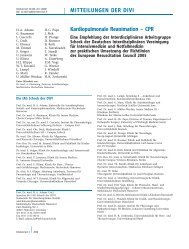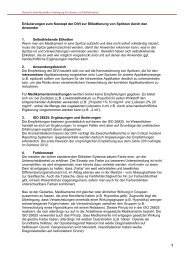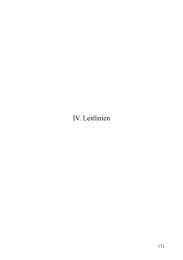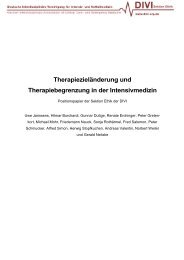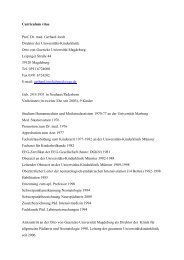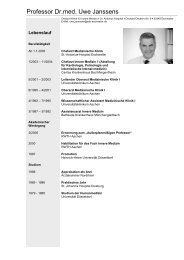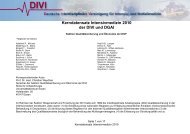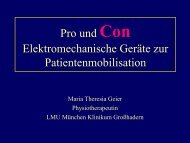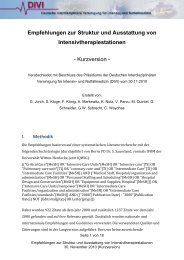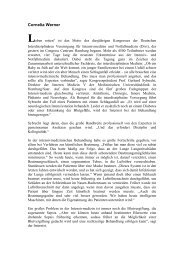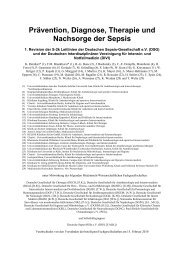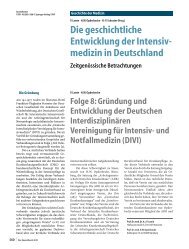Enterale Ernährung auf der Intensivstation
Enterale Ernährung auf der Intensivstation
Enterale Ernährung auf der Intensivstation
You also want an ePaper? Increase the reach of your titles
YUMPU automatically turns print PDFs into web optimized ePapers that Google loves.
<strong>Enterale</strong> <strong>Ernährung</strong> bei<br />
kreisl<strong>auf</strong>gestützter Sepsis: Pro
Interessenskonflikte<br />
Zuwendungen von folgenden Unternehmen:<br />
-Abbott GmbH<br />
-Baxter Deutschland<br />
-B.Braun Melsungen AG<br />
-Danone<br />
-Fresenius Kabi Deutschland GmbH<br />
-MSD Sharp & Dohme GmbH<br />
-Nestlé Health Care Nutrition GmbH
<strong>Ernährung</strong> <strong>auf</strong> <strong>der</strong> <strong>Intensivstation</strong>
<strong>Ernährung</strong> <strong>auf</strong> <strong>der</strong> <strong>Intensivstation</strong><br />
Moore et al, Nutr Clin Pract 2009; 24: 297 - 304
<strong>Ernährung</strong> <strong>auf</strong> <strong>der</strong> <strong>Intensivstation</strong><br />
Pichard et al, Clin Nutr 2009; 4 (Suppl. 1): 3 - 7
<strong>Ernährung</strong> <strong>auf</strong> <strong>der</strong> <strong>Intensivstation</strong><br />
Alberda et al, Intensive Care Med 2009; 35: 1728 - 1737
ESPEN Guidelines on Parenteral Nutrition:<br />
Intensive Care<br />
Patients should be fed because starvation or un<strong>der</strong>feeding<br />
in ICU patients is associated with increased morbidity and<br />
mortality. Grade C<br />
Singer et al, Clin Nutr 2009; 28: 387-400
<strong>Ernährung</strong> <strong>auf</strong> <strong>der</strong> <strong>Intensivstation</strong><br />
� Warum enteral ?
<strong>Ernährung</strong> <strong>auf</strong> <strong>der</strong> <strong>Intensivstation</strong><br />
Moore et al, Nutr Clin Pract 2009; 24: 297 - 304
<strong>Ernährung</strong> <strong>auf</strong> <strong>der</strong> <strong>Intensivstation</strong><br />
Moore et al, Nutr Clin Pract 2009; 24: 297 - 304
<strong>Ernährung</strong> <strong>auf</strong> <strong>der</strong> <strong>Intensivstation</strong><br />
Johnson et al, Ann Surg 2003; 237: 565 - 573
Perioperative<br />
<strong>Ernährung</strong><br />
Lewis et al,<br />
J Gastrointest Surg 2009;<br />
13: 569 - 575
Perioperative <strong>Ernährung</strong><br />
Osland et al, JPEN 2011; 15: 473-487
If the gut works, use it !
<strong>Enterale</strong> <strong>Ernährung</strong><br />
Metaanalysis of 48 PRCT (12 critically ill)<br />
� EN: more diarrhea<br />
� PN: more often hyperglycemia in the ICU<br />
� EN: less infectious complications<br />
� no difference in mortality<br />
Koretz et al, Am J Gastroenterol 2007; 102: 412-429
<strong>Enterale</strong> und parenterale <strong>Ernährung</strong><br />
beim kritisch Kranken<br />
Pichard et al, Clin Nutr 2009; 4 (Suppl. 1): 3 - 7
<strong>Enterale</strong> und parenterale <strong>Ernährung</strong><br />
beim kritisch Kranken<br />
Elke, G et al, Crit Care Med 2008; 36: 1762 - 1767
Liver dysfunction associated with artificial nutrition in<br />
critically ill patients<br />
Multivariate analysis of 725 patients :<br />
Liver dysfunction was associated with<br />
� TPN (p
<strong>Enterale</strong> and parenterale <strong>Ernährung</strong><br />
beim kritisch Kranken<br />
Death by TPN... The final chapter?<br />
Crit Care Med 2008; 36: 1964-1965
ESPEN Guidelines Enteral Nutrition - Intensive Care<br />
...The expert committee however favours the<br />
view that critically ill patients who are<br />
haemodynamically stable and have a<br />
functioning gastrointestinal tract should be<br />
fed early (
SCCM / A.S.P.E.N. – Guidelines<br />
Nutrition support therapy in the adult<br />
critically ill patient<br />
EN is the preferred route of feeding over parenteral nutrition<br />
(PN) for the critically ill patient who requires nutrition<br />
support therapy. (Grade: B)<br />
McClave et al, JPEN 2009; 33: 277 - 316
S2k-Leitlinie <strong>der</strong> Deutschen Sepsis Gesellschaft<br />
Enteral vs. parenteral<br />
� Grundsätzlich gilt, dass die enterale <strong>Ernährung</strong> die<br />
bevorzugte Form <strong>der</strong> <strong>Ernährung</strong> bei kritisch Kranken<br />
darstellt.<br />
� Empfehlung Grad E (V: Expertenmeinung)<br />
Reinhart K et al Intensivmed 2010; 47: 185-207
<strong>Ernährung</strong> <strong>auf</strong> <strong>der</strong> <strong>Intensivstation</strong><br />
Barr et al, Chest 2004; 125: 1446 - 1457
<strong>Ernährung</strong> <strong>auf</strong> <strong>der</strong> <strong>Intensivstation</strong><br />
Drover et al, JPEN 2010; 34: 644 - 652
<strong>Ernährung</strong> <strong>auf</strong><br />
<strong>der</strong><br />
<strong>Intensivstation</strong><br />
Barrett et al;<br />
JPEN 2009;<br />
33: 21 - 26
Canadian Clinical Practice Guidelines<br />
- Intensive Care -<br />
Small bowel feeding improves calorie and<br />
protein intake and is associated with less time<br />
taken to reach target of enteral nutrition when<br />
compared to gastric feeding.<br />
Heyland et al, www.criticalcarenutrition.com, Update, January 31, 2009
Sondenzugang beim kritisch Kranken<br />
NG - Sonde<br />
Magen-Residualvolumen > 500ml<br />
Jejunalsonde<br />
orale <strong>Ernährung</strong> nicht<br />
innerhalb von 3 Tagen möglich<br />
� dringlich endoskopisch<br />
falls Laparotomie falls EN > 4 Wochen<br />
FKJ intraop. Sondenplatzierung<br />
Jejunum<br />
PEG<br />
PEJ
Sondenzugang beim kritisch Kranken<br />
Montejo et al, Intens Care Med 2010;36: 1386-1393
<strong>Ernährung</strong> <strong>auf</strong> <strong>der</strong> <strong>Intensivstation</strong><br />
� <strong>Enterale</strong> <strong>Ernährung</strong> bei<br />
hämodynamischer Instabilität
SCCM / A.S.P.E.N. – Guidelines<br />
Nutrition support therapy in the adult<br />
critically ill patient<br />
In the setting of hemodynamic compromise ( patients<br />
requiring significant hemodynamic support including<br />
high dose catecholamine agents, alone or in combination<br />
with large volume fluid or blood product resuscitation<br />
to maintain cellular perfusion), EN should be withheld<br />
until the patient is fully resuscitated and/or stable. (Grade: E)<br />
McClave et al, JPEN 2009; 33: 277 - 316
Tabelle: Fälle ischämischer Darmnekrose bei enteraler <strong>Ernährung</strong><br />
Autor Jahr<br />
Patienten mit<br />
enteraler<br />
<strong>Ernährung</strong><br />
Fälle mit<br />
ischämischer<br />
Darmnekrose<br />
Thompson 1983 k.A. 1 (k.A.) k.A.<br />
Mortalität<br />
Gaddy et al 1986 143 5 (3,5%) 5 (100%)<br />
Brenner and<br />
Schellhammer<br />
1987 33 1 (3%) 1 (100%)<br />
Smith-Choban et al 1988 143 5 (3,5%) 5 (100%)<br />
Schunn and Daly 1995 1359 4 (0,3%) 2 (50%)<br />
Myers et al 1995 2022 3 (0,14%) 2 (67%)<br />
Rai 1996 k.A. 2 (k.A.) 1 (50%)<br />
Kowal-Vern et al 1997 2114 10 (0,47) k.A.<br />
Lawlor et al 1998 386 3 (0,7%) 0 (0%)<br />
Scaife et al 1999 k.A. 4 (k.A.) 0 (0%)<br />
Holmes et al 1999 222 3 (1,4%) k.A.<br />
Munshi et al 2000 k.A. 1 (k.A). 1 (100%)<br />
Jorba et al 2000 k.A. 1 (k.A.) 1 (100%)<br />
Marvin et al 2000 4311 13 (0,3%) 6 (46%)<br />
Hirota et al 2003 120 5 (4,1%) 5 (100%)<br />
Melis et al 2006 k.A. 1 (k.A.) 1 (100%)<br />
Nesseler et al 2006 k.A. 2 (k.A.) 2 (100%)<br />
Besselink et al 2008 298 9 (3,02%) 8 (89%)<br />
Total 73 40 (68%)<br />
k.A. - keine Angaben im Artikel<br />
Ischämische<br />
Darmnekrose<br />
Nolopp et al, 2011
<strong>Enterale</strong> <strong>Ernährung</strong> beim Intensivpatienten<br />
Nutr Clin Pract 2003; 18: 279 - 284
<strong>Enterale</strong> <strong>Ernährung</strong> beim kritisch Kranken<br />
Zaloga et al, Nutr Clin Pract 2003; 285 - 293
Ischämische Darmnekrose<br />
Vollmar et al, Langenbecks Arch Surg 2011; 396: 13 - 29
<strong>Enterale</strong> <strong>Ernährung</strong> beim kritisch Kranken<br />
Krejci et al, Crit Care Med 2006; 34: 2406 - 2424
<strong>Enterale</strong> <strong>Ernährung</strong> bei<br />
hämodynamischer<br />
Instabilität<br />
Thibault et al,<br />
Intensive Care Med 2011;<br />
37: 35 - 45
<strong>Enterale</strong> <strong>Ernährung</strong> bei<br />
hämodynamischer<br />
Instabilität<br />
Khalid et al,<br />
Am J Crit Care 2010;<br />
19: 261 - 268
<strong>Enterale</strong> <strong>Ernährung</strong> bei hämodynamischer Instabilität<br />
n=467<br />
n=707<br />
Khalid et al, Am J Crit Care 2010; 19: 261 - 268
<strong>Enterale</strong> <strong>Ernährung</strong> bei hämodynamischer Instabilität<br />
Khalid et al, Am J Crit Care 2010; 19: 261 - 268
<strong>Enterale</strong> <strong>Ernährung</strong> bei hämodynamischer Instabilität<br />
Khalid et al, Am J Crit Care 2010; 19: 261 - 268
<strong>Enterale</strong> <strong>Ernährung</strong> bei<br />
hämodynamischer Instabilität<br />
Khalid et al,<br />
Am J Crit Care 2010;<br />
19: 261 - 268
<strong>Enterale</strong> <strong>Ernährung</strong> bei hämodynamischer Instabilität<br />
n=357<br />
n=357<br />
Khalid et al, Am J Crit Care 2010; 19: 261 - 268
<strong>Enterale</strong> <strong>Ernährung</strong> bei hämodynamischer Instabilität<br />
Khalid et al, Am J Crit Care 2010; 19: 261 - 268
Kombinierte „balancierte“ enterale / parenterale <strong>Ernährung</strong><br />
Chirurgie: Ösophagusresektion<br />
EN + PN<br />
Lid<strong>der</strong> et al, Br J Nutr 2010; 103: 1635-1641
<strong>Ernährung</strong> <strong>auf</strong> <strong>der</strong> <strong>Intensivstation</strong><br />
� <strong>Enterale</strong> Substratzufuhr anstatt<br />
kalorienbedarfsdecken<strong>der</strong> <strong>Ernährung</strong> ?
<strong>Ernährung</strong> <strong>auf</strong> <strong>der</strong> <strong>Intensivstation</strong><br />
� An<strong>der</strong>e Sondennahrung ?<br />
Schwerpunkt: Spezielle Substrate
<strong>Ernährung</strong> <strong>auf</strong> <strong>der</strong> <strong>Intensivstation</strong><br />
� Glutamin<br />
� Antioxidanzien<br />
� Butyrat
<strong>Ernährung</strong> beim<br />
Intensivpatienten<br />
Beale et al,<br />
Crit Care Med 2008;<br />
36: 131-144
<strong>Ernährung</strong> <strong>auf</strong> <strong>der</strong> <strong>Intensivstation</strong><br />
� Neue Sondensysteme?
<strong>Enterale</strong>r <strong>Ernährung</strong>smonitor/-manager Y2K2 ®<br />
nach G. Moss
<strong>Enterale</strong> <strong>Ernährung</strong> <strong>auf</strong> <strong>der</strong><br />
<strong>Intensivstation</strong><br />
Sondenvorschlag Anfor<strong>der</strong>ungen:<br />
Nolopp et al, 2011<br />
2- / 3-lumig<br />
• beide Lumina<br />
jejunal platzierbar<br />
(mind. 150 cm)<br />
• 16-18 CH,<br />
CAVE: Gesetz von<br />
Hagen-Poiseuille!<br />
• dünner Mantel<br />
(ggf. mit Stahlfe<strong>der</strong>)<br />
• Cardiaballon
<strong>Ernährung</strong> <strong>auf</strong> <strong>der</strong> <strong>Intensivstation</strong><br />
� Besseres Monitoring ?
Gastrointestinal Failure Score<br />
Points Clinical symptomatology<br />
0 Normal gastrointestinal function<br />
1 Enteral feeding
Gastrointestinal Failure and ICU Mortality<br />
Reintam et al, Crit Care 2008; 12: R90
<strong>Ernährung</strong> <strong>auf</strong> <strong>der</strong> <strong>Intensivstation</strong><br />
Markogiannakis et al, Surgery 2011; 149: 394-403
Allgemeinchirurgische <strong>Ernährung</strong> <strong>auf</strong> <strong>der</strong> <strong>Intensivstation</strong><br />
Notfälle<br />
Markogiannakis et al, Surgery 2011; 149: 394-403
<strong>Ernährung</strong> <strong>auf</strong> <strong>der</strong> <strong>Intensivstation</strong><br />
Howell et al, Crit Care Med 2011; 39: 322 - 327
Enteral nutrition in case of hemodynamic compromise<br />
1. EN is possible … in patients with acute severe<br />
circulatory failure (provided that careful abdominal<br />
monitoring is maintained and the delivery of EN<br />
is progressive)<br />
2. EN generally results in insufficient energy delivery<br />
3. Combination of EN with PN should be consi<strong>der</strong>ed<br />
4. EN should be avoided in patients with documented<br />
bowel ischemia<br />
Berger and Chiolero, JPEN 2009; 33: 702-709
<strong>Enterale</strong> <strong>Ernährung</strong> bei Intensivpatienten<br />
Praktisches Vorgehen und Monitoring<br />
� langsame Steigerung: <strong>auf</strong> max. 50 ml/h innerhalb <strong>der</strong><br />
ersten vier Tage in 10 - 20 ml-Schritten/Tag unter<br />
Beobachtung <strong>der</strong> Toleranz durch Sondenrückfluß und<br />
Distension<br />
� bei hämodynamischer Instabilität sofortige Reduktion<br />
<strong>der</strong> Zufuhrraten (<strong>auf</strong> 5 - 20ml/h – “minimal enteral<br />
feeding“)<br />
– ggf. vorübergehen<strong>der</strong> Stopp<br />
� strenge Beobachtung <strong>der</strong> Peristaltik<br />
vor allem bei Zufuhrraten > 40 ml/h<br />
DGEM-Arbeitsgruppe Chirurgie und Transplantation, 2003
<strong>Enterale</strong> <strong>Ernährung</strong> bei hämodynamischer Instabilität<br />
Early trickle feeding (trophic feeding) is<br />
probably the strategy that maximizes the<br />
benefits and minimizes the risks associated<br />
with early EN. Starting with a rate of 20ml/hour<br />
is reasonable with stepwise<br />
M. Berger, Intensivmed 2011; 28: 117-118
Mnemonic:<br />
CAN WE FEED<br />
� Critical illness severity<br />
� Age<br />
� Nutritional Risk Screening<br />
� Wait for resuscitation<br />
� Energy requirements<br />
� Formula selection<br />
� Enteral access<br />
� Efficacy<br />
� Determine tolerance<br />
Miller et al, JPEN 2011; 35: 643-659
<strong>Enterale</strong> <strong>Ernährung</strong> bei hämodynamischer Instabilität<br />
� Ja - mit minimaler Zufuhrrate<br />
� Strenge Beobachtung und Monitoring<br />
� Innovative Sondensysteme und -<br />
nahrung
Leipzig<br />
31.08.-03.09.2013
<strong>Ernährung</strong> <strong>auf</strong> <strong>der</strong> <strong>Intensivstation</strong><br />
� Früh vs. spät
ESPEN Guidelines on Parenteral Nutrition:<br />
Intensive Care<br />
All patients who are not expected to be on normal nutrition<br />
within 3 days should receive PN within 24-48h if EN is<br />
contraindicated or if they cannot tolerate EN (Grade C)<br />
Singer et al, Clin Nutr 2009; 28: 387- 400
SCCM / A.S.P.E.N. – Guidelines<br />
Nutrition support therapy in the adult<br />
critically ill patient<br />
If early EN is not feasible or available the first 7 days<br />
following admission to the ICU, no nutrition support<br />
therapy (ie, STD therapy) should be provided. (Grade: C)<br />
McClave et al, JPEN 2009; 33: 277 - 316
<strong>Enterale</strong> <strong>Ernährung</strong><br />
Cahill et al, JPEN 2011; 35: 160 - 168
Early vs. late feeding<br />
Kutsogiannis et al, Crit Care Med 2011; 39: Epub ahead of print
Early vs. late feeding<br />
Kutsogiannis et al, Crit Care Med 2011; 39: Epub ahead of print
Conclusion:<br />
Early vs. late feeding<br />
� The supplemental use of parenteral nutrition may<br />
improve provision of calories and protein but is not<br />
associated with any clinical benefit.<br />
Kutsogiannis et al, Crit Care Med 2011; 39 Epub ahead of print
Early vs. late<br />
feeding<br />
Casaer et al,<br />
N Engl J Med 2011; 365:<br />
506-517
Early vs.<br />
late feeding<br />
Casaer et al,<br />
N Engl J Med 2011;<br />
365: 506-517
Early vs. late feeding<br />
� Inflammation is lower in the early initiation group !<br />
Median peak C-reactive protein level during ICU stay (interquartile<br />
range) — mg/liter<br />
Late initiation group (N=2328): 190.6 (100.8–263.2)<br />
Early initiation group (N=2312): 159.7 (84.3–243.5)<br />
p
Kritikpunkte:<br />
Early vs. late feeding<br />
Casaer et al, N Engl J Med 2011<br />
� NRS wurde bei 45% durch die Intensivpflichtigkeit<br />
definiert – Schwäche des NRS ?<br />
� 44% hatten einen BMI geringer als 25kg/m2<br />
� Hyperkalorische <strong>Ernährung</strong> mit Glukose – 2880 kcal<br />
� Intensivliegedauer sehr kurz: 3 (2-7) vs. 4 (2-9) Tage
Hyperglycemia<br />
Insulin<br />
- +<br />
Mitochondria<br />
Early vs. late feeding<br />
Injury,<br />
Inflammation<br />
+<br />
- - Autophagia - -<br />
Repair<br />
Fasting<br />
Hypothesis:<br />
G..d. Berghe, ESPEN Congress, Gothenburg, 06-09-11<br />
Insufficient activation of autophagy allows cellular<br />
damage to accumulate in critically ill patients<br />
J Clin Endocrinol Metab 2011; 96: E633-45<br />
Nutrients
Künstliche <strong>Ernährung</strong><br />
Krishnan et al, Chest 2003; 124: 297 - 305
S2k-Leitlinie <strong>der</strong> Deutschen Sepsis Gesellschaft<br />
<strong>Ernährung</strong> und metabolische Kontrolle<br />
� Für alle Patienten, die voraussichtlich nicht innerhalb<br />
von 3 Tagen vollständig mit normaler Kost ernährt werden<br />
können, wird eine künstliche <strong>Ernährung</strong> empfohlen. Dies gilt<br />
beson<strong>der</strong>s bei Vorliegen eines reduzierten<br />
<strong>Ernährung</strong>sstatus.<br />
� Empfehlung Grad E (V: Expertenmeinung)<br />
Reinhart K et al Intensivmed 2010; 47: 185-207
S2k-Leitlinie <strong>der</strong> Deutschen Sepsis Gesellschaft<br />
Enteral vs. parenteral<br />
� Es wird nicht empfohlen, Patienten ohne Zeichen <strong>der</strong><br />
Mangelernährung, die voraussichtlich weniger als 5 Tage<br />
nicht ausreichend enteral ernährt werden können,<br />
vollständig parenteral zu ernähren.<br />
� Empfehlung Grad E (V: Expertenmeinung)<br />
Reinhart K et al Intensivmed 2010; 47: 185-207
S2k-Leitlinie <strong>der</strong> Deutschen Sepsis Gesellschaft<br />
Enteral vs. parenteral<br />
� Es wird empfohlen, die Patienten von Anbeginn <strong>der</strong><br />
Intensivtherapie parenteral zu ernähren, die voraussichtlich<br />
auch nach einem Zeitraum von 5-7 Tagen nicht ausreichend<br />
oral o<strong>der</strong> enteral ernährt werden können.<br />
� Empfehlung Grad B (Evidenzgrad Ic)<br />
Reinhart K et al Intensivmed 2010; 47: 185-207
ESPEN Guidelines on Parenteral Nutrition:<br />
Intensive Care<br />
During acute illness the aim should be to provide energy<br />
as close as possible to the measured energy expenditure<br />
in or<strong>der</strong> to decrease negative energy balance (Grade B).<br />
In the absence of indirect calorimetry ICU patients should<br />
receive 25 kcal/kg/day increasing to target over the<br />
next 2-3 days (Grade C).<br />
Singer et al, Clin Nutr 2009; 28: 387- 400
<strong>Ernährung</strong> <strong>auf</strong> <strong>der</strong> <strong>Intensivstation</strong><br />
� Lücke zwischen endogener Glukoseproduktion und exogener Kalorienzufuhr?<br />
100%<br />
80%<br />
60%<br />
40%<br />
20%<br />
0%<br />
endogene<br />
Glukoseproduktion<br />
0%<br />
0 1 2 3 4 5 6 7 8 9 10<br />
Tage<br />
exogene<br />
Exogene<br />
Zufuhr<br />
Zufuhr<br />
zusätzliche Katabolie<br />
100%<br />
80%<br />
60%<br />
40%<br />
20%
Kombiniert enterale / parenterale <strong>Ernährung</strong><br />
parenteral KH : Fette = 70 : 30 (50 : 50)<br />
Kohlenhydrate max. 3-4 g/kg KG/d Glukose<br />
Fette max. 0.7-1.5 g/kg KG/d<br />
Aminosäuren max. 1.3-1.5 g/kg KG/d<br />
enteral 10 - 25 ml/h - nur sehr vorsichtig steigern !<br />
Monitoring Serum-Glukose (4.5-6.1 mmol/l, < 150<br />
mg/dl)<br />
(täglich) Triglyzeride (< 3.5 mmol/l)<br />
Laktat<br />
PCT<br />
fakultativ: Indirekte Kalorimetrie
ESPEN Guidelines on Parenteral Nutrition:<br />
Intensive Care<br />
Are micronutrients required?<br />
All PN prescriptions should include a daily dose of<br />
multivitamins and of trace elements. Grade C<br />
Singer et al, Clin Nutr 2009; 28: 387-400
ESPEN Guidelines on Parenteral Nutrition:<br />
Intensive Care<br />
PN admixtures should be administered as a complete<br />
all-in-one bag (Grade B).<br />
Singer et al, Clin Nutr 2009; 28: 387- 400
SCCM / A.S.P.E.N. – Guidelines<br />
Nutrition support therapy in the<br />
adult critically ill patient<br />
Immune-modulating enteral formulations (supplemented with agents<br />
such as arginine, glutamine, nucleic acid, �-3 fatty acids, and antioxidants)<br />
should be used for the appropriate patient population (major elective<br />
surgery, trauma, burns, head and neck cancer, and critically ill patients<br />
on mechanical ventilation), with caution in patients with severe sepsis.<br />
(for surgical ICU patients, Grade: A)<br />
(For medical ICU patients, Grade: B)<br />
ICU patients not meeting criteria for immune-modulating formulations<br />
should receive standard enteral formulations. (Grade: B)<br />
McClave et al, JPEN 2009; 33: 277 - 316
S2k-Leitlinie <strong>der</strong> Deutschen Sepsis Gesellschaft<br />
Immunonutrition<br />
� Für Patienten mit schwerer Sepsis o<strong>der</strong> septischem<br />
Schock ist <strong>der</strong> Einsatz von immunnutritiven Formeln<br />
mit einem erhöhten Letalitätsrisiko assoziiert und kann<br />
daher nicht empfohlen werden.<br />
� Empfehlung Grad B (Evidenzgrad Ib)<br />
Reinhart K et al Intensivmed 2010; 47: 185-207
S2k-Leitlinie <strong>der</strong> Deutschen Sepsis Gesellschaft<br />
Omega-3 Fettsäuren<br />
� Eine kontinuierliche enterale <strong>Ernährung</strong> mit Omega-3-<br />
Fettsäuren in Kombination mit Antioxidanzien kann<br />
erwogen werden.<br />
� Empfehlung Grad C (Evidenzgrad Ib)<br />
Reinhart K et al Intensivmed 2010; 47: 185-207
S2k-Leitlinie <strong>der</strong> Deutschen Sepsis Gesellschaft<br />
Glutamin<br />
� Es wird empfohlen, kritisch Kranken, die ausschließlich<br />
parenteral ernährt werden, zusätzlich zur parenteralen<br />
Aminosäurenzufuhr parenteral Glutamindipeptid<br />
zuzuführen.<br />
� Empfehlung Grad (Evidenzgrad V: Expertenmeinung)<br />
Reinhart K et al Intensivmed 2010; 47: 185-207
DGEM-Leitlinie 2007<br />
Parenterale <strong>Ernährung</strong><br />
� Bei kritisch Kranken sollte im Akutstadium die zugeführte<br />
Energie im Bereich des aktuellen Gesamtenergieumsatzes<br />
o<strong>der</strong> leicht darunter liegen (B).<br />
� Bei kritisch Kranken, die das Akutstadium überwunden<br />
haben, sollte die Energiezufuhr schrittweise <strong>auf</strong> das<br />
1,2 fache (bei gleichzeitiger Mangelernährung bis 1,5 fach)<br />
des aktuellen Energieumsatzes gesteigert werden (C).<br />
Energieumsatz und -zufuhr<br />
Kreymann et al, Aktuel Ernaehr Med 2007; 32: S8-S12
Clinical nutrition in the critically ill<br />
Peterson et al, J Am Diet Assoc 2010; 110: 427 - 433
<strong>Ernährung</strong> <strong>auf</strong> <strong>der</strong> <strong>Intensivstation</strong><br />
� Enteral o<strong>der</strong> parenteral ?<br />
Das ist nicht mehr die Frage –<br />
son<strong>der</strong>n<br />
� Ab wann wird enteral und parenteral<br />
„dual“ ernährt?
Band 48; Heft 2,<br />
März 2011



